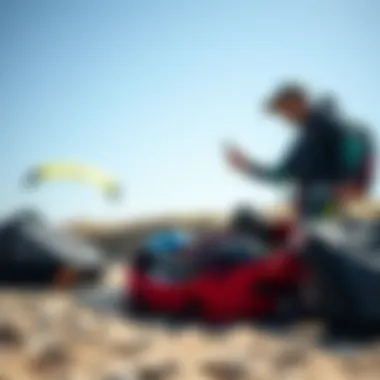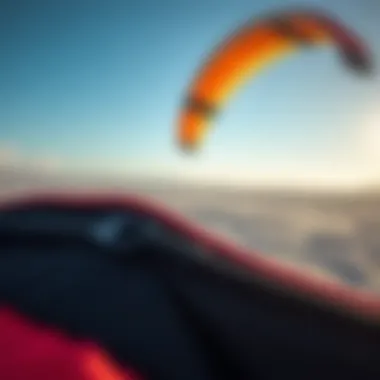The Ultimate Guide to Choosing Kite Travel Bags


Intro
Kite surfing and kiting in various forms are thrilling sports, often described as a melange of adrenaline and artistry. However, a critical yet often underappreciated aspect of enjoying kiteboarding is the gear that facilitates travel—specifically, kite travel bags. With various options available, understanding these bags' significance is essential, whether you're a novice setting out to ride the waves for the first time or a seasoned professional participating in global competitions.
This guide will lead you through the remarkable world of kite travel bags, dissecting their design features, material options, and vital considerations for selection. We aim to clear the clouds of confusion surrounding these essential carriers while providing recommendations tailored to the needs of kiteboarders from all walks of life.
Gear and Equipment
Kiteboarding isn’t just about skill; it’s also about having the right gear to ensure a smooth experience. Understanding the importance of having a specialized travel bag for your kite gear can enhance your overall kiteboarding adventures and ensure your equipment remains in good shape.
Essential Kiteboarding Gear: A Comprehensive Guide
When it comes to kiteboarding, packing the right gear can mean the difference between a successful day on the water and a trip filled with mishaps. Here’s a rundown of the essentials:
- Kite: The core of your kiteboarding experience. Make sure it suits your skill level and local wind conditions.
- Board: Choose from various types, such as twin-tips or directional boards. Each has its pros and cons.
- Harness: A comfortable harness is key. Look for styles that fit snugly yet allow for movement.
- Wetsuit or Drysuit: Depending on your location, having the appropriate thermal protection is crucial against the elements.
- Control Bar and Lines: Ensure these are compatible with your kite, as they control the kite's maneuverability.
Selecting a travel bag that fits all these essentials is paramount. Besides, the right bag not only protects your gear but also allows for efficient mobility from one spot to another.
Maintenance Tips for Kiteboarding Equipment
Taking good care of your gear can prolong its lifespan, thus saving you money down the road. Consider these simple maintenance tips:
- Rinse: After every session, rinse your kite and lines with fresh water to remove salt or sand that can cause wear and tear.
- Dry Graciously: Ensure your equipment is completely dry before packing it away. Mold can be a sneaky enemy.
- Check Regularly: Inspect your kite for any minor repairs needed, like patching small tears or replacing frayed lines.
- Store Smartly: Keep your gear in a cool, dry place, away from direct sunlight to prevent degradation of materials.
Taking time to care for your kiteboarding equipment not only enhances your experience but also preserves the investment you've made.
"The best kite is the one that suits your style and needs. Don’t settle for less."
In the upcoming sections, we will delve deeper into kite travel bags' design features, usability, and the different types available in the market. Understanding these factors is crucial for anyone looking to embark on kiting adventures, ensuring a seamless and enjoyable experience.
Understanding Kite Travel Bags
When venturing into the world of kiteboarding, having the right gear goes beyond just selecting a kite. Kite travel bags play a pivotal role in ensuring that your equipment is safe, organized, and easy to transport. Understanding kite travel bags means recognizing their various designs, materials, and the unique needs they serve for enthusiasts and professionals alike.
The significance of kite travel bags lies in their ability to protect fragile gear, facilitate easy movement during travel, and enhance overall convenience. As kiteboarders traverse areas with different environmental conditions and travel hurdles, a well-constructed bag offers not just utility but peace of mind. The challenge, however, is to find the right bag that aligns with your style and needs while addressing practicality and durability.
Definition and Purpose
At its core, a kite travel bag is specifically designed for storing and transporting kiteboarding equipment, including the kite itself, control bars, lines, and other essentials.
These bags are often padded to protect expensive gear during transport. Some bags come with compartments for organized packing, which can be a real advantage when you’re in a hurry or if your travel itinerary is packed tight. Essentially, the purpose of a kite travel bag is to provide a streamlined solution that caters to both the casual traveler and the serious adventurer.
Historical Context
Kiteboarding has witnessed rapid evolution since its inception, leading to corresponding advancements in gear bags. In the early days, kiteboarders mainly improvised with regular duffel bags or even simple backpacks. These makeshift solutions often lacked adequate protection, leading to damaged equipment and frustration during transit.
As kiteboarding gained popularity, manufacturers recognized the need for specialized gear transportation. Over the years, the design of kite travel bags adapted to emerging trends, with an increase in lightweight materials and innovative designs catering to travel demands. From the basic models of the past to contemporary bags equipped with wheels and ergonomically designed straps, kite travel bags have transformed significantly, thus ensuring that the kiteboarder can focus on their performance rather than the hassles of travel.
Key Features of Effective Kite Travel Bags
Picking the right kite travel bag is not just a matter of convenience; it's a step towards ensuring your gear is well-protected and easily accessible during your adventures. Understanding the essential features of these bags can make a world of difference for kiteboarders, whether they're just getting started or have been utilizing the wind for years. Evaluating size, weight, the quality of materials, and functional design elements will help craft the ideal bag for your specific needs. Here, we dive deep into the vital traits that elevate a good kite travel bag to an exceptional one.
Size and Dimensions
Size matters when it comes to kite travel bags. A bag too large can become cumbersome, making it a hassle to carry or stow away, while one that’s too small risks leaving your precious gear exposed to the elements or, worse, damaged during transit. Most kite bags are designed to accommodate a range of items, from the kite itself to bars, harnesses, and even wings for those who embrace newer forms of kite sports.
When choosing a bag, consider your gear configuration. For instance, if you’re packing multiple kites—for an array of wind conditions—opt for a bag that accommodates these sizes without scrimping on protection. Most brands provide dimensions to enable you to measure against your gear accordingly.
"Selecting the right size is like finding a pair of shoes that fits exactly; it makes everything smoother on the road."
Weight Considerations


In kite travel, every ounce counts. A lightweight bag allows for easier maneuverability and may even keep you beneath weight limits imposed by airlines. Conversely, a heavier bag can quickly transform the joy of travel into a tiring expedition. Look for features like lightweight frames and material that provide sturdiness without unnecessary heft. Generally, bags designed with strong yet lightweight fabrics, such as ripstop nylon or polyester blends, can offer the best balance.
Remember: it's not just the bag's standalone weight; you need to factor in how it interacts with the weight of your gear. A good practice is to try packing the bag as you would for a real trip and ensure you remain comfortable lifting it.
Material Quality
The durability of materials used in kite travel bags is paramount for long-term use. High-quality fabrics resist abrasion and tears, crucial when handling equipment in rugged conditions. Look for bags made from water-resistant materials that also breathe, preventing moisture buildup from rain or humidity.
Commonly, travelers favor bags made from polyvinyl chloride or high denier fabric for robust performance. Specialized features such as reinforced seams and heavy-duty zippers can greatly enhance longevity. Remember, your gear's experience in transit should mirror its experience on the water, meaning premium materials are not an option but a necessity.
Straps and Handles
The ease of carrying a kite travel bag largely hinges on the quality and design of its straps and handles. A well-padded shoulder strap can take a load off your shoulders, especially during lengthy walks or when navigating uneven terrain. Some bags also come with additional carrying options like backpack-style straps or haul handles, which enhance versatility.
Adjustability is another key feature. You want straps that can accommodate your height or preferred carry style without slipping off. Handles should be sturdy—no one wants a bag slipping from their grip at a crucial moment while boarding a plane!
Wheels and Mobility
Mobility can save any kiteboarder from unnecessary strain, more so when navigating airports or transporting gear through busy streets. Bags equipped with wheels simplify transport, letting you glide along instead of lugging heavy loads. Look for bags that feature durable wheels, which can withstand harsh conditions while still rolling smoothly.
Some models also offer hybrid designs with retractable straps for easy conversion between rolling and carrying. When traveling through a bustling airport or embarking on a rugged terrain trek, such adaptability proves invaluable. The right wheeled bag does more than ease your load; it represents an investment in your overall travel enjoyment.
Types of Kite Travel Bags
When it comes to kite travel, the type of bag you choose can make all the difference. Kite travel bags are designed to safely store and transport your kite gear to and from your adventures. Understanding the distinct types of bags available not only streamlines your packing but also ensures that your equipment arrives intact, ready for action. The various options offer unique advantages and serve specific purposes. Hence, it’s imperative to delve into the category of kite travel bags to find one that fits your individual needs.
Soft Bags
Soft bags represent the most versatile and lightweight option on the market. They are crafted from durable yet flexible materials that allow for easy manipulation, squeezing into tight spaces when needed. Soft bags typically feature multiple compartments, making it simpler to organize kites, harnesses, and other accessories.
Here are some attractive factors about soft bags:
- Lightweight: They add minimal weight to your gear, crucial for air travel.
- Cost-Effective: Generally, soft bags are less expensive than hardcase options, perfect for budget travelers.
- Compressible: If you’re short on storage space, these bags can often fold up when empty.
However, keep in mind that they may not offer the same level of protection as harder counterparts. So, if you are traveling to remote areas with rugged transport conditions, consider how that might affect your gear's safety.
Hardcase Bags
Hardcase bags stand out for their sheer robustness and protective capabilities. Often built using high-density materials, they provide a sturdy barrier against shocks and impacts, shielding valuable gear from potential damage during travel.
This sort of bag is particularly beneficial in the following scenarios:
- Long Distance Transport: If you're catching flights or embarking on lengthy road trips, a hardcase can guard against severe bumps and drops.
- Lockable Options: Many hardcase bags come equipped with locks, adding an extra layer of security to deter unauthorized access.
- Weather Resistance: They often feature water-resistant designs, keeping your gear dry during unexpected weather.
There are, however, trade-offs to consider, such as increased weight and a premium price tag compared to softer models.
Backpacks
Backpacks truly shine when it comes to convenience and mobility. They're ideal for kiteboarders who opt for accessible adventure spots like nearby beaches or local lakes. A backpack offers the ability to transport everything you need comfortably without requiring a cart or assistance.
Key benefits include:
- Hands-Free Mobility: Perfect for hiking to remote launch sites; they allow you to carry equipment easily.
- Organizational Features: Various pockets for different items—like wetsuits, tools, or snacks—keep you organized on the go.
- Ergonomic Designs: Many backpacks are designed to distribute weight effectively to avoid strain.
One potential downside is the limitations on storage when compared to larger bags. It’s worth considering how much gear you plan to take before committing.
Hybrid Options
Hybrid options strike a balance between the traditional soft and hardcase models. These bags combine features from both types to cater to a wide range of preferences and travel situations. With certain sections being harder for protection and other sections softer for flexibility, hybrids can be a smart choice for many kiteboarders.
Some prominent aspects of hybrid options include:


- Customizable Spaces: Many hybrids can be adapted for different gear arrangements, providing unique compartments suited to individual needs.
- Versatility: They can be utilized in different travel scenarios, whether by plane, train, or on foot.
- Stylish Designs: Hybrids often feature modern and trendy aesthetics that might appeal to travelers looking for function and style.
Each type of kite travel bag comes with its own set of strengths and weaknesses, and the best choice will largely depend on personal preferences, travel habits, and budget considerations. Make an informed decision by considering how you plan to use your gear, and ensure that your chosen bag meets your expectations for durability and functionality.
Choosing the Right Bag
Selecting the appropriate kite travel bag is a critical decision for any kiteboarding enthusiast. The right bag not only protects your gear but also facilitates a convenient travel experience, enabling you to focus more on the thrill of kiteboarding rather than dealing with gear mishaps. The choice hinges on several factors, including your skill level, travel habits, and budget.
Assessing Skill Level
When choosing a kite travel bag, it’s essential to consider your skill level as a kiteboarder. Beginners may prefer softer bags since they offer flexibility and are easier to manipulate, fitting snugly into various transport environments. On the other hand, seasoned riders might appreciate the robustness of hardcase bags that provide superior protection against impacts. For instance, a hardcase bag can withstand rough handling at the airport, which is a real concern if you've ever seen how baggage handlers operate.
- For Beginners: Opt for a lightweight soft bag that’s easy to carry. A bag like the Naish Kite Travel Bag offers ample room for your kite and accessories without being too bulky.
- For Experienced Riders: Consider investing in a durable hardcase, such as the Mystic Warrior Pro. It promises better protection, especially when you're traveling internationally.
Travel Habits and Destinations
Next, your travel habits and destinations play a huge role in finding the right kite travel bag. If you frequently hop on planes to exotic kiteboarding locations, durability and security become paramount. Conversely, if your adventures mostly involve local trips to the beach, a simpler, more portable design might suffice.
- International Travel: Seek a bag with sturdy wheels and additional padding like the Duotone Kiteboarding Travel Bag. It can handle the rigors of international logistics and still hold your precious gear safe.
- Local Adventures: A compact backpack like the Cabrinha Kitesurf Backpack can be more practical for casual trips. It’s easy to carry around and provides quick access to your gear.
"The right travel setup can make or break your kiteboarding experience, allowing you to explore new locations with ease."
Budget Considerations
Your budget is another crucial element when pondering over a kite travel bag. Prices can range from affordable soft bags to high-end durable hard cases. Striking the right balance between quality and cost is essential.
- Entry-Level: If you’re a beginner or don’t plan to travel frequently, a more modestly priced bag might do just fine. Look for options that offer decent protection without burning a hole in your pocket, like the Brunotti Kite Bag.
- Investment in Quality: If kiteboarding is a long-term passion, consider investing in a higher-end bag. Premium options from brands like Peter Lynn provide excellent materials that withstand wear and tear over time, ultimately saving you money on replacements.
In summary, choosing the right bag entails weighing your skill level, travel patterns, and financial capacity. Each paddleboard adventure is unique, and your bag should reflect that. By understanding these factors, you’ll be equipped to make a smart purchase that enhances your kiteboarding experience.
Maintenance and Care
Proper maintenance and care are pivotal when it comes to kite travel bags. These bags endure numerous travel conditions, from sandy beaches to rocky terrains, each presenting unique challenges that can wear them down over time. To ensure longevity and functionality, understanding how to clean and store your travel bag correctly becomes essential. Maintaining your gear not only preserves its quality but also enhances its performance, keeping it your reliable companion for those thrilling kiteboarding sessions.
Cleaning Techniques
Keeping your kite travel bag clean is one of the most straightforward yet effective ways to ensure its durability. Cleaning methods may vary depending on the material of the bag. Here are some practical tips:
- Spot Clean Regularly: After every trip, use a damp cloth to wipe off any dirt, sand, or saltwater residue that might have accumulated during your travel. This simple act can prevent buildup that might damage the fabric.
- Use Mild Soap: For a more thorough cleaning, fill a tub or sink with lukewarm water and add a small amount of mild detergent. Soak the areas of the bag that are particularly soiled and gently scrub with a soft brush or cloth. Rinse well, ensuring that no soap residue is left behind.
- Air Dry Completely: Once cleaned, hang the bag in a well-ventilated area to air dry. Avoid direct sunlight for extended periods, as it can fade colors and weaken materials.
"A little care goes a long way. Think of maintenance as an investment in your gear's lifespan."
Following these cleaning techniques will not only enhance the appearance of your bag but also maintain its structural integrity over time.
Storage Recommendations
Storing your kite travel bag correctly is equally significant as its cleaning. Here are essential recommendations for optimal storage:
- Keep it Dry: Make sure your travel bag is completely dry before storing it. Moisture can lead to mold and mildew, which could ruin not just the bag but also your kite gear packed inside.
- Avoid Extreme Temperatures: Store your bag in a cool, dry place. Avoid attics or basements where temperatures might fluctuate excessively. An ideal storage location is a closet or a storage bin that protects it against environmental changes.
- Use a Bag Storage Sack: If possible, store your travel bag inside a sack specifically designed for storage. This provides an added layer of protection against dust and potential damages.
- Regular Check-ins: Periodically check on your stored bag to ensure its condition remains intact and to catch any potential issues early on.
Using these maintenance and care techniques ensures that your kite travel bag serves you well for years to come, allowing you to focus on your adventures rather than worrying about your equipment.
Traveling with Kite Gear
Traveling with kite gear can sometimes feel like a riddle wrapped in a mystery inside an enigma. If you’re a kiteboarder, you know that your gear is your lifeline to the sky. Ensuring you have everything in order is crucial, not just for convenience, but to avoid potential headaches when you arrive at your destination. From understanding airline regulations to implementing smart packing strategies, this section lays out essential considerations to make your kite travel smoother than a well-pressed kite.
Airline Regulations
Navigating airline regulations can be a game of chess for travelers with sports equipment like kite gear. There’s no sugar-coating it; each airline has its own policies, and sometimes, they might seem as clear as mud. Before you even book a ticket, dive into the specifics of what your chosen airline allows regarding sports equipment. Generally, airlines tend to categorize kiteboarding gear—kites, boards, harnesses, and other accessories—under the broad umbrella of ‘sports equipment’.
- Weight Limitations: Most airlines enforce stringent weight limits, often within the range of 23 to 32 kilograms (50 to 70 pounds) for checked baggage. If you’re hauling extra gear, consider that you could be looking at additional fees.
- Dimensions: It’s common for airlines to have size restrictions as well. You might find that oversized items attract additional fees, or worse—they might not even be allowed.
- Protection of Gear: Always check if the airline has a recommendation or requirement for how to pack your kite gear. Some might suggest hard cases to ensure everything survives the trip intact.


A good resource to stay updated on regulations is the airline's official website or even forums like reddit.com where fellow kiteboarders share their first-hand experiences.
"Taking the time to understand airline regulations can save you from unnecessary heartbreak at the check-in counter. Know what to expect before the flight, and you can face those travel hurdles head-on."
Packing Strategies
Packing your kite gear is a skill all on its own. It’s about finding the right balance between protecting your precious toys and ensuring you're not paying an arm and a leg in baggage fees. Here are some key packing strategies to consider:
- Use a Size-Appropriate Bag: Make sure the bag you opted for fits your kite gear snugly. If there’s too much extra space, your gear might bounce around, risking damage.
- Distribute Weight Evenly: Packing heavier items like boards towards the bottom and lighter items like kites on top can help maintain balance. It’s all about that center of gravity.
- Protective Wrapping: Consider using clothing or towels as padding. Stuff your harness and smaller items in the nooks and crannies to minimize shifting. This padding can go a long way in absorbing knocks that happen in transit.
- Document Your Gear: When packing up for the trip, take photos of your packed items. This can help prove ownership and completeness should you need to file a claim for lost or damaged equipment later on.
Ultimately, being organized and strategic in your packing not only protects your gear but also reduces stress when you navigate through busy terminals or cramped cars.
By taking note of these airline regulations and carefully employing packing strategies, you can make traveling with kite gear a much less daunting endeavor.
User Reviews and Community Insights
User reviews and community insights play a crucial role in shaping one’s understanding of kite travel bags. These insights come not only from the experiences of countless users but also reflect a wealth of practical knowledge that is often absent in product descriptions or marketing brochures. When you're out there, hovering in the skies or zipping across the water, you want to ensure that the bag protecting your gear is up to the task. It’s here that the voices of fellow kiteboarders can guide you in your decision-making process.
Why User Feedback Matters
First and foremost, real-world user feedback provides an honest assessment of how travel bags perform in diverse conditions. Unlike flashy advertisements, reviews often reveal the strengths and weaknesses of specific models. Users might share experiences regarding durability after a few trips or the ease of packing and unpacking gear, which is invaluable for anyone considering an investment in these bags.
Additionally, reviews often highlight usability factors such as comfort during transport. Consider a backpack-style kite travel bag; users will emphasize whether the straps dig into shoulders after an hour of carrying or if the bag remains comfortable on long treks. The challenges faced and solutions found by others can serve to directly influence your choice.
Community Insights on Popular Choices
The kiteboarding community has its favorites when it comes to brands and specific models. Names like Ozone and Slingshot often come up in many discussions,
that showcase why kiteboarders prefer them. Often, these brands focus on quality materials and innovative designs, which appeals to the seasoned traveler.
"Investing in a good kite travel bag is as crucial as the kite itself. You can't risk your gear getting damaged just because of a flimsy bag!"
— Kiteboarding enthusiast
Key Considerations in User Reviews
When browsing through community reviews, certain factors stand out:
- Material Quality
Many users stress the importance of high-quality materials that can withstand wear and tear. - Size and Capacity
The bag’s ability to accommodate different types of gear can determine its suitability for varying kite sizes. - Cost vs. Value
A look into whether the investment aligns with your travel habits will keep your wallet happy.
Used wisely, these insights can transform a potential guessing game into a more informed strategy when selecting a kite travel bag. Armed with shared experiences, perspectives, and perhaps a few cautionary tales, you can navigate the multitude of options available with more assurance.
Popular Brands and Models
Researching brands and models that have received praise within the kiteboarding community can recommend excellent choices. Popular names in kite travel bags include:
- Ozone - Recognized for its lightweight yet durable bags designed specifically for kiteboard gear.
- Slingshot - Known for offering robust bags that hold up against saltwater and rough handling.
- North Kiteboarding - Frequently lauded for a thoughtful design with enough padding to protect kites during transport.
Exploring user forums and reviews can provide a deeper understanding of these suggestions, helping decide which one resonates best with personal preferences and travel styles.
Personal Experiences
Listening to personal stories can be a game changer when deciding on the right travel bag. Many kiteboarders share tales of their travels, revealing which bags survived turbulent flights and unforeseen weather. For instance, some users mention how their Ozone bag endured the rigors of a rugged road trip through adverse climates, returning home with nary a scratch on the gear. Others recount the convenience found in a Slingshot wheeled bag that made navigating busy airports significantly less stressful, given the often cumbersome nature of kite gear.
In these narratives, not merely facts but feelings emerge, painting a picture of what it's like to depend on a travel bag while chasing winds and waves. Many report their regrets too; perhaps a cheap bag that detoured gears covered in mud a few dozen miles from home after bursting at the seams.
These stories, whether they carry a note of triumph or caution, serve as valuable guidance for prospective buyers looking for something that’ll last through various adventures. By diving into these personal encounters, anyone considering a new kite travel bag can gain insights and possibly avoid common slips made by others.
Epilogue
Selecting the right kite travel bag is not merely a matter of convenience; it is integral to enhancing the overall kiteboarding experience. This guide highlights how such bags serve as essential gear for kiteboarders and outdoor enthusiasts alike, offering a protective and organized method to transport their valuable equipment. A well-chosen bag safeguards against damage while traveling, ensuring that the kite and accompanying gear remain intact and ready for action whenever the opportunity arises.
Recap of Key Points
In reviewing the myriad of aspects discussed throughout this article, several key takeaways emerge:
- Size and Dimensions: Understanding the importance of size in relation to your gear helps to streamline packing and improve mobility.
- Material Quality: The materials used in construction dictate not only durability but also performance under various weather conditions.
- Types of Bags: Knowledge of different bag types aids in making informed decisions tailored to individual travel habits and preferences.
- User Reviews: Insights from the kiteboarding community provide valuable perspectives on how specific bags fare in real-world conditions, offering guidance based on personal experiences.
These points collectively underscore the importance of investing time and effort into selecting a kite travel bag that aligns with your specific needs.
Future Developments in Gear
Looking forward, the evolution of kite travel bags may be influenced by advancements in technology and changing travel paradigms. Manufacturers are likely to emphasize innovative designs that blend aesthetics with functionality, integrating features like smart technology for tracking bags or even modular components that allow for customizable space configurations. Sustainability is an increasing concern; hence, using eco-friendly materials in the production of kite bags may not just be a trend, but the norm.
With the ever-changing landscape of travel regulations and considerations, brands may also adapt their offerings to address emerging needs. The continuous dialogue between manufacturers and the kiteboarding community could foster enhancements that not only meet but exceed user expectations. Keeping an eye on these developments ensures that kiteboarders remain equipped with the best gear available, poised to take on new adventures with confidence.
As the kiteboarding landscape evolves, so do the needs and preferences of its enthusiasts. Staying informed and adaptable is paramount.















